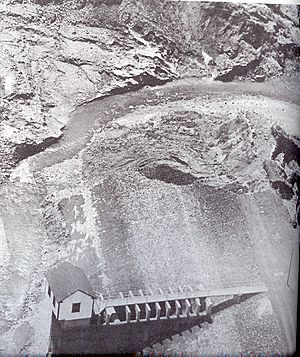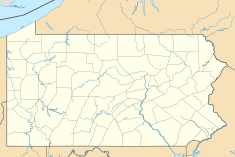Laurel Run Dam facts for kids
Quick facts for kids Laurel Run Dam |
|
|---|---|

Laurel Run dam failure in 1977
|
|
|
Location of Laurel Run Dam in USA Pennsylvania
|
|
| Location | West Taylor Township, Cambria County, near Johnstown, Pennsylvania, United States |
| Coordinates | 40°23′03″N 78°54′56″W / 40.38417°N 78.91556°W |
| Construction began | 1915 |
| Opening date | 1919 |
| Demolition date | July 20, 1977 |
| Owner(s) | Johnstown Water Authority |
| Dam and spillways | |
| Type of dam | Earthen embankment |
| Impounds | Laurel Run Creek |
| Height | 42 feet (13 m) |
| Reservoir | |
| Creates | Laurel Run Reservoir |
| Total capacity | 101,000,000 US gallons (380,000 m3) |
| Catchment area | 18 square miles (47 km2) |
| Surface area | 22 acres (89,000 m2) |
The Laurel Run Dam, also known as Laurel Run Dam No. 2, was a large earth-filled dam. It tragically failed during the Johnstown Flood of 1977. This dam held the most water among seven dams that broke between July 19 and 20, 1977. Its failure caused the most deaths of the two dams that led to fatalities. The dam broke in the early morning of July 20 after a lot of rain. This sent a huge amount of water, about 101 million US gallons (380,000 m³), rushing into the town of Tanneryville downstream. Sadly, 40 people lost their lives in this event.
Building the Dam
During the 1860s, the Johnstown Water Company planned new ways to provide water for the city of Johnstown, Pennsylvania. They first chose Laurel Run and Wild Cat Creeks as water sources. A dam was built on Laurel Run Creek in 1869. This created Laurel Run reservoir No. 1, which held about 9 million US gallons (34,000 m³) of water. Water from this reservoir traveled through a long pipe to the older parts of Johnstown. However, this first reservoir was later closed in 1910 because of water pollution and because bigger reservoirs were being built.
After another reservoir called Saltlick was finished, workers and equipment moved to build the new Laurel Run reservoir No. 2. Construction started in 1915. The new dam and reservoir were completed in 1919. This much larger reservoir could hold about 101 million US gallons (380,000 m³) of water. The dam was also designed so it could be made even bigger in the future.
The 1977 Dam Failure
On the night of July 19, 1977, very heavy rains poured down on the Johnstown area. At 2:35 A.M. on July 20, the Laurel Run Dam broke. The powerful flood that followed killed 40 people. It also destroyed 9 homes and damaged 19 others in the town of Tanneryville, which was downstream. Most people were sleeping when the dam failed. There was no warning system in place along the narrow valley below the dam. Also, the heavy rain and darkness made it very hard for anyone to escape.
The dam's failure caused about $5.3 million in damages. The Laurel Run Dam broke because too much water flowed over its top, which wore away its structure. Six other dams also failed that day. Four of these were small, and two were minor in size. The Sandy Run Dam failure caused five deaths and was the only other dam break that led to fatalities during the flood.
What Happened After the Flood
Experts later found that the Laurel Run Dam failed because its spillway (a channel for water to flow over or around the dam) was not designed well enough. There were also problems with the dam's stability. Some people also said that existing safety rules for dams in Pennsylvania were not properly enforced.
Concerns about the dam had been brought to the attention of the Greater Johnstown Water Authority officials before the flood. Engineering experts had given them advice, but their suggestions were not followed for many years. An engineer named Elio D'Appolonia, who had studied the dam in the 1960s, said that if the dam had been updated with modern safety practices, it would have been able to handle the storm.
Families affected by the flood later took legal action against the Greater Johnstown Water Authority and the companies involved in the dam's maintenance and management. They also took action against the Pennsylvania Department of Environmental Resources. Even though information showed that all these groups could have taken steps to prevent the dam's failure, the cases were settled out of court in 1989. The exact amount of the settlement was not made public.
After the terrible events of July 1977, the Laurel Run Dam was never rebuilt. In 1990, the land where the dam once stood, and the area below it, was named "Laurel Run Park" by West Taylor Township. Today, the exact spot of the dam is a grassy field with some trees and a park bench near the creek. The area that used to be the reservoir is now a wetland, full of different plants and animals.


